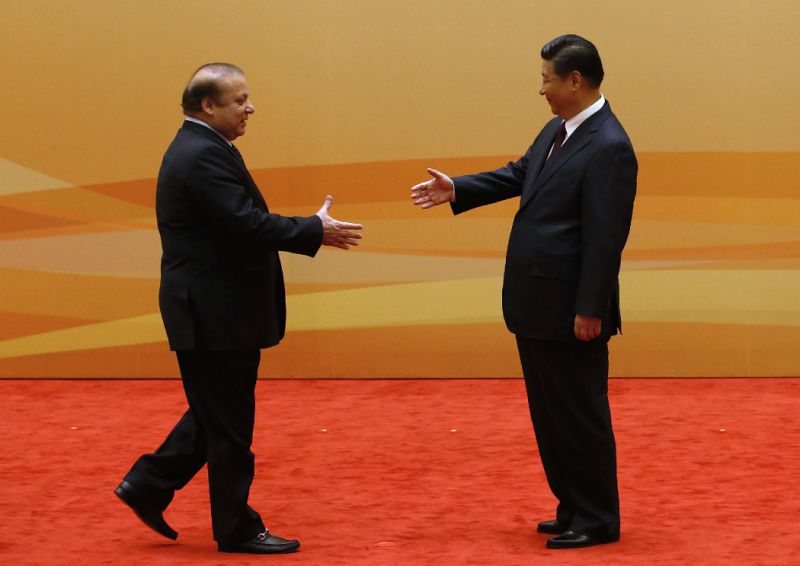
The president warned the international community that no one will emerge as a winner in the ongoing trade war where he compared protectionism with “locking oneself in a dark room without light and air”. He defended economic openness and emphasised that globalisation was not responsible for economic woes in the west for which it was being blamed.
China ready to take CPEC forward with Pakistan: spokesperson
The speech was taken by surprise especially at the time when the United States (US), the world’s largest economy, under the leadership of Donald Trump was bent upon erecting barriers against free movement of goods, services and people. Meanwhile, in the European Union (EU), there are also increasing political sentiments against free trade that is being blamed for unemployment.
Such statements in defence of globalisation from a country that was being criticised for distorting free market economy by erecting various layers of protectionism, including currency manipulation, were quite unthinkable until recently.
As the political leadership in the US and the EU have come under tremendous pressure from their domestic constituencies against economic globalisation, which they perceive as responsible for economic deprivation, China is seeing this as an opportunity to quickly fill the vacuum and assume leadership as champion for free trade and globalisation.
In the past two decades, the Chinese economy has outperformed others and emerged as the world’s fastest growing economy with an average of 10% Gross Domestic Product growth per year. The export-led economic growth model pursued by China created conducive environment for relocation of labour intensive manufacturing from other regions of the world, especially from the west where high labour and environmental costs were affecting the competitiveness of global firms. China had the right ingredients that included skilled workforce and supporting infrastructure to facilitate such relocations.
This led to transformation of China not only as the global hub of manufacturing but also an export powerhouse. Despite this remarkable economic performance, China still has vast swath of underdeveloped areas where a large portion of the population is still living in poverty. China would obviously like to continue with this trajectory of economic growth and development so as to be able to lift a significant portion of its population still living in poverty.
The sabre rattling by the current US administration has created considerable concern globally and is being seen as a big blow to the efforts initiated under former President Barack Obama and his “Pivot to East Asia” policy that focused in enhancing strategic and economic cooperation in the Asia Pacific.
The Trans Pacific Partnership (TPP), one of the flagship initiatives that envisaged free movement of goods and services among 12 Pacific countries including the US, envisaged an ambitious agenda to create the world’s biggest free trade area representing 40% of global trade. However, Trump, on the 3rd day of his presidency, signed an executive order withdrawing from the TPP. This provided an opportunity to China to fill the vacuum where it has joined the TPP as an observer with the hope of gaining full membership.
Skill development needed to benefit from globalisation
Additionally, China is pushing another ambitious initiative in the Asia Pacific to secure its export interests through Free Trade Areas of Asia Pacific (FTAAP) that includes 20 countries of the region. And it is also close to concluding the Asia Pacific Regional Economic Comprehensive Partnership (RCEP) where the coverage of trade is even bigger than the TPP. The other members of RCEP include India, Japan and other members of the Association of Southeast Asian Nations (ASEAN).
Concern for Pakistan
In the meantime, Pakistan in its “Look East Policy” has been striving in addressing tariff and non-tariff barriers for its core export interest in the region. Pakistan is also keen in joining ASEAN as a full dialogue partner, including a free trade agreement with its members. But these gestures have not received much attention from the association.
In the last couple of years, Pakistan’s export performance has been lacklustre and the growth is almost stagnant despite a number of policy incentives. The improvement in the macroeconomic indicators and better security situation has not helped much in enhancing the country’s exports. The main impediment remains the tariff barrier.
The only region where Pakistan has witnessed growth for its exports has been the EU due to the tariff concessions under the GSP Plus scheme. However, these concessions are time bound and subject to rigorous monitoring of the country’s social, labour and environment standards.
Philippine officials to visit Beijing to discuss investment deals, ASEAN summit
Pakistan is not included in any of the regional negotiations being led by China despite having close political and economic ties with it.
The emerging regional trade arrangements led by China with ambitious tariff cuts will have adverse effects on exports from non-parties such as Pakistan and this should be a cause of concern for Islamabad.
The writer is a development professional with over 20 years of experience in public and development sectors
Published in The Express Tribune, April 3rd, 2017.
Like Business on Facebook, follow @TribuneBiz on Twitter to stay informed and join in the conversation.

1717587923-0/jake-paul-vs-mike-tyson-(1)1717587923-0-165x106.webp)


1725443747-0/Untitled-design-(5)1725443747-0-165x106.webp)












COMMENTS (19)
Comments are moderated and generally will be posted if they are on-topic and not abusive.
For more information, please see our Comments FAQ